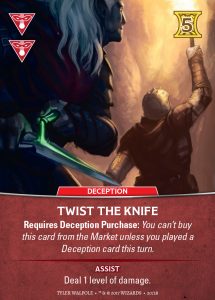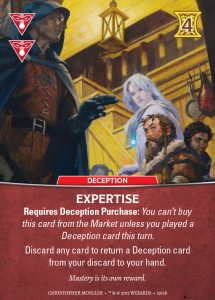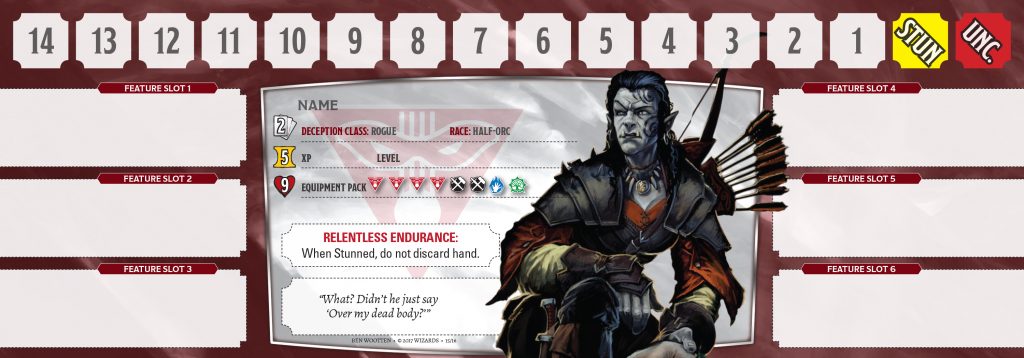In the last post I thoroughly discussed the Equipment Pack, which is built from Basic Market cards and becomes your draw deck at the start of the game. However, as with any good deckbuilder game, Dragonfire is about building your deck.
The base game includes a sixty-card deck, split equally between the four colored Class Types: Arcane (blue), Deception (red), Devotion (green), and Martial (black). [By the end of these blogs, you’re going to have those colors and names down pat!]
At the start of the game, you reveal six cards. Well, the standard is six cards. You can reveal less or more based on a variety of situations. For example, one of the monthly Adventures I just turned over to layout—Chaos in the Trollclaws—includes a Market card that occupies a slot until they’re all purchased. And then you have the Half-Elf, which adds a slot to the Market! And so on.
Regardless, you’ll have a number of cards you may purchase during the game. Now the term “Market” represents purchasing cards with earned gold, not a literal market that springs up in the depths of a dungeon. Rather, the character has gained access to a new ability. For example, a Wizard who purchases a Fireball card is discovering, remembering, or preparing that potent spell. So it’s a mechanism that needs to work in this fashion for the game engine, but we try and skew the Creative aspect to help with any potential disconnects.
If you remember way back in the beginning, I discussed the color wheel: the flavor and type of play that comes out in a given color/Class Type. For example, the Devotion character heals heavily and color shifts. The Arcane player churns through his deck hunting for arguably the most powerful cards in the game: Lightning Bolt and Fireball. The Deception character continually draws their best cards back out of their discard pile. The Martial plants himself in the way of attacking encounters to take the hits, while trying to set match Sword icons on Martial cards to draw new cards.
Each has a distinct flavor that quickly starts to come to the fore. Though, even with those flavors, there are several different slants on those play styles, creating different games. Even two players both playing a Human Rogue in the same game might play two heavily different-slanted styles. And that’s not even getting into what Feature stickers will allow as we dive into Subclasses (more on that in future posts).
Let’s delve into one specific flavor that is arguably the most distinctive in the base game (I said I was going to to show some Rogue love). Let’s take a look at Twist the Knife—one of the best Assists in the game. That level damage allows you to knock down almost anything. (You’ll remember in a previous post I discussed that even with the Deception Purchase requirements it’s so good we introduced the Immune to Level Damage icon to shore-up the Encounters Decks.)

However, there’s only two Twist the Knife cards in the entire Market Deck. Not to mention, by the time you’re buying it, you’re likely already over a dozen cards in your deck. Which means it can take a while to cycle through and have that card show up again.
(The Devotion characters have the most difficult time at recursion—moving quickly through the deck—and having played a Cleric more than anything else…there are times I’m jealous of the Rogue’s ability.)

Yet there’s a hand-in-glove card for Twist the Knife in Expertise. Take a look at it and you’ll immediately realize what’s going on. Now imagine: there’s three total Expertise in the market and you manage to get two of them in your deck? Or the dream: you get all three Expertise and the two Twist the Knife. You’re slicing and dicing almost every turn through encounters as any slip-from-the-shadows-to-strike Rogue should be!
Remember that’s just one tactic the Rogue can use; albeit it’s the favorite. Two other variations are oriented around the Feint and Perception cards. The former opens the ability to stab anywhere along an encounter’s damage track, while the later lets you Skill Check for gold. So many great options. And every Class Type brings that similar flexibility to the table, which means no player will play the same Class the same way.
Until next time!
Randall

